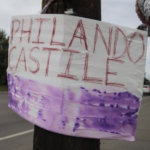Surviving a Police Encounter – Part 4 Complying with the Officer
Surviving a Police Encounter
Part 4: Complying with the officer
 The world learned the name Philando Castile after his girlfriend, Diamond Reynolds, live-streamed the immediate aftermath of the police shooting that took his life. “We got pulled over for a busted taillight in the back,” she says on the video. The camera reveals Castile slumped over in his seat; his shirt soaked with his own blood.
The world learned the name Philando Castile after his girlfriend, Diamond Reynolds, live-streamed the immediate aftermath of the police shooting that took his life. “We got pulled over for a busted taillight in the back,” she says on the video. The camera reveals Castile slumped over in his seat; his shirt soaked with his own blood.
“And the police. . . he’s killed my boyfriend,” Reynolds says. “He’s licensed to carry. He was trying to get out his ID and his wallet out of his pocket, and he let the officer know that he had a firearm, and he was reaching for his wallet.”
In our series “Surviving a Police Encounter,” we’ve been exploring “The Three Cs”: Caring, Communication, and Compliance. Retired Oklahoma City Police Lieutenant Stan Campbell developed “The Three Cs” as part of D.O.P.E. the Movement, an organization devoted to educating police and civilians alike on tactics for De-escalating Officer Patrol Encounters.
We’ve illustrated how dangerous traffic stops can be for law enforcement officers by exploring the high-profile murders of Deputy Kyle Dinkheller and Officer Darrian Jarrott. Criminal defense and civil rights attorney Lorenzo Banks, who has joined Stan’s efforts through D.O.P.E. the Movement, acknowledges “Just like you get nervous when you’re getting pulled over at two o’clock in the morning, this officer’s kind of nervous. He wants to go home. She wants to go home to her son. He wants to go home to his spouse.” Both Stan and Lorenzo agree that when a motorist demonstrates they care about the officer’s safety — by pulling over quickly when stopped and making their hands visible — it goes a long way to making the encounter safe for both parties.
We’ve also established that good communication is key to a safe encounter with law enforcement. As an example, we looked at the case of Lavar Jones who reached quickly into his car in response to a highway patrolman’s command of “Can I see your license, please?” The trooper feared Jones was reaching for a gun, he over-reacted and shot the unarmed motorist in the hip. Even though the law enforcement officer admitted guilt and acknowledged the motorist did nothing wrong, we explored the possibility that, if Jones had communicated that his license was in his vehicle and asked for permission to retrieve it, he very likely would have prevented the unjustified shooting that followed.
That brings us back to the deadly shooting of Philando Castile. Officer Jeronimo Yanez was charged with manslaughter amidst the national outcry after Diamond Reynolds video made headlines. At trial, jurors saw something the public had not seen: dashcam video from Yanez’s cruiser. Days after the jury found Yanez not guilty, the video was released to the press.
In the video, the encounter gets started on the right foot. It seems Castile pulled over promptly after the officer signaled the stop. Castile’s window is down as the officer approaches, and he greets the officer with a calm, respectful tone. “How are you?” he asks. “Good,” the officer replies. The driver has accomplished the first “C”; he’s demonstrated he cares about the officer’s safety.
The officer then informs Castile that his brake lights are not working properly. “Do you have your license and insurance?” the officer asks. The microphone picks up some rustling of papers. Then Castile speaks, “Sir, I have to tell you I do have a firearm on me.” This is the second “C”; he’s communicating something that is very important to the officer’s safety. What happens next is puzzling.
“Don’t reach for it then,” the officer says. “I’m not pulling it out,” Castile replies. In the video, we can’t see what’s happening in the car, but we do witness the officer’s posture and demeanor change as his voice becomes more emphatic. The officer reaches for his holstered gun. “Don’t pull it out,” he says. “I’m not pulling it out,” Castile replies.
“Don’t pull it out,” the officer commands a final time. Then he draws and fires several rounds into the vehicle to the sound of screaming from within.
Castile, at first, acted as if he cared about the officer’s safety. He communicated that he had a firearm, which was the right thing to do, but from what we can glean from the limited perspective provided by the officer’s dashcam, Castile either refused to comply with the officer’s commands or was confused and seemed not to comply. Either way, in the seconds after telling the officer that he had a deadly weapon, Castile failed to demonstrate clear, unequivocal compliance to the officer’s commands. Stan adds, “If a citizen can tell the anxiety of the officer is elevated, it is best not to make any moves whatsoever.” Stan also says in this case, “Keep your hands on the wheel and continue to communicate that you do not plan to hurt the officer.”
Was the officer justified in shooting Philando Castile? That’s not entirely clear. While a jury acquitted Yanez of manslaughter, the city of St. Anthony issued a statement that read: “The public will be best served if Officer Yanez is no longer a police officer in our city.”
In retrospect, we can ask whether Officer Yanez was right or wrong in his decision to use deadly force, but for Philando Castile, it wasn’t a matter of right or wrong, it was a matter of life or death. Right or wrong, failure to comply with an officer’s commands, especially when the officer feels his or her safety is on the line, can result in death.
In Kenosha, Wisconsin, Jacob Blake defied officers’ orders and marched around his vehicle, and reached into the passenger compartment before he was shot several times. Now he’s partially paralyzed. In Chicago, Illinois, Laquan McDonald ignored officers’ commands as he strutted past their patrol cars armed with a knife. He was shot 16 times. Now he’s dead. Kenosha County District Attorney Michael Graveley declined to charge Officer Rusten Sheskey in the Blake case, stating he “would not be able to disprove the officer’s self-defense claims.” Jason Van Dyke was found guilty of second-degree murder in the shooting of Laquan McDonald, but that can’t bring McDonald back.
Arguably, failure to comply with officers’ commands contributed to the shooting of Michael Brown in Ferguson, Missouri, the suffocating deaths of Eric Garner and George Floyd, and sadly, countless other cases that have made headlines in the past several years. Did the non-compliance justify the deadly reaction from the police officers? In most cases, no. But for the purposes of saving lives, this is not about right or wrong, this is about life or death. Stan often states, “In a police encounter, toe-tags matter, so we must all do our part to de-escalate.”
Citizens are legally required to comply with the lawful commands of law enforcement officers. Sometimes those commands might not seem fair, and sometimes, you may doubt whether the officer is within his or her rights to issue certain commands. Civil rights attorney Lorenzo Banks represents citizens who have had their rights violated by cops who have overstepped their legal authority. “You’re not going to win the argument on the side of the road with a cop,” Lorenzo says. The best thing to do is comply. You can calmly and respectfully state that you feel your rights are being violated. If it doesn’t interfere with an officer’s lawful commands, you can record the incident to use as evidence. And if you are right about the violation of your civil rights, a civil rights attorney like Lorenzo Banks and seek justice in a court of law.
“We have to protect ourselves from officers lying to us and encroaching on our rights,” Lorenzo says. “But we also have to protect ourselves from doing something that will ultimately escalate the situation to where we find ourselves severely hurt or potentially deceased.”
Stan says, “The courtroom is the place to make your argument, not the curbside.”
D.O.P.E. the Movement is all about making sure people survive encounters with law enforcement with their rights intact. Survival is the first order of business because, as Stan says, “Comply so you can complain later. No one can fight for their own justice if they don’t survive the encounter.”

SHAWN VINCENT – LITIGATION CONSULTANT
Shawn Vincent is a litigation consultant who helps select
juries in self-defense cases, and he manages public interest
of high-profile legal matters. If you have any questions for
Shawn, or would like topic specific articles, please send your
request to dopethemovementinfo@gmail.com attention Shawn Vincent Articles.#
Leave a Comment
You must be logged in to post a comment.


